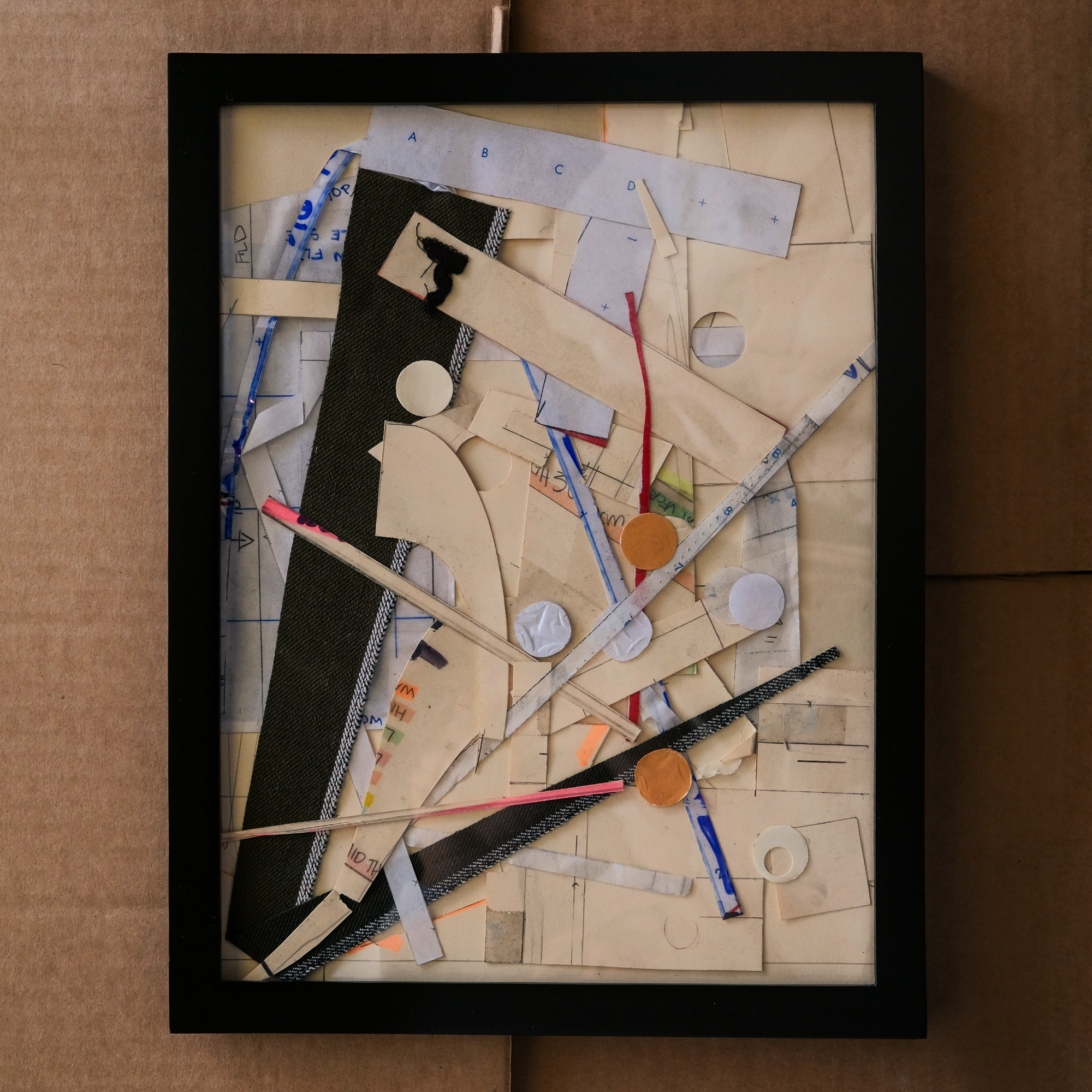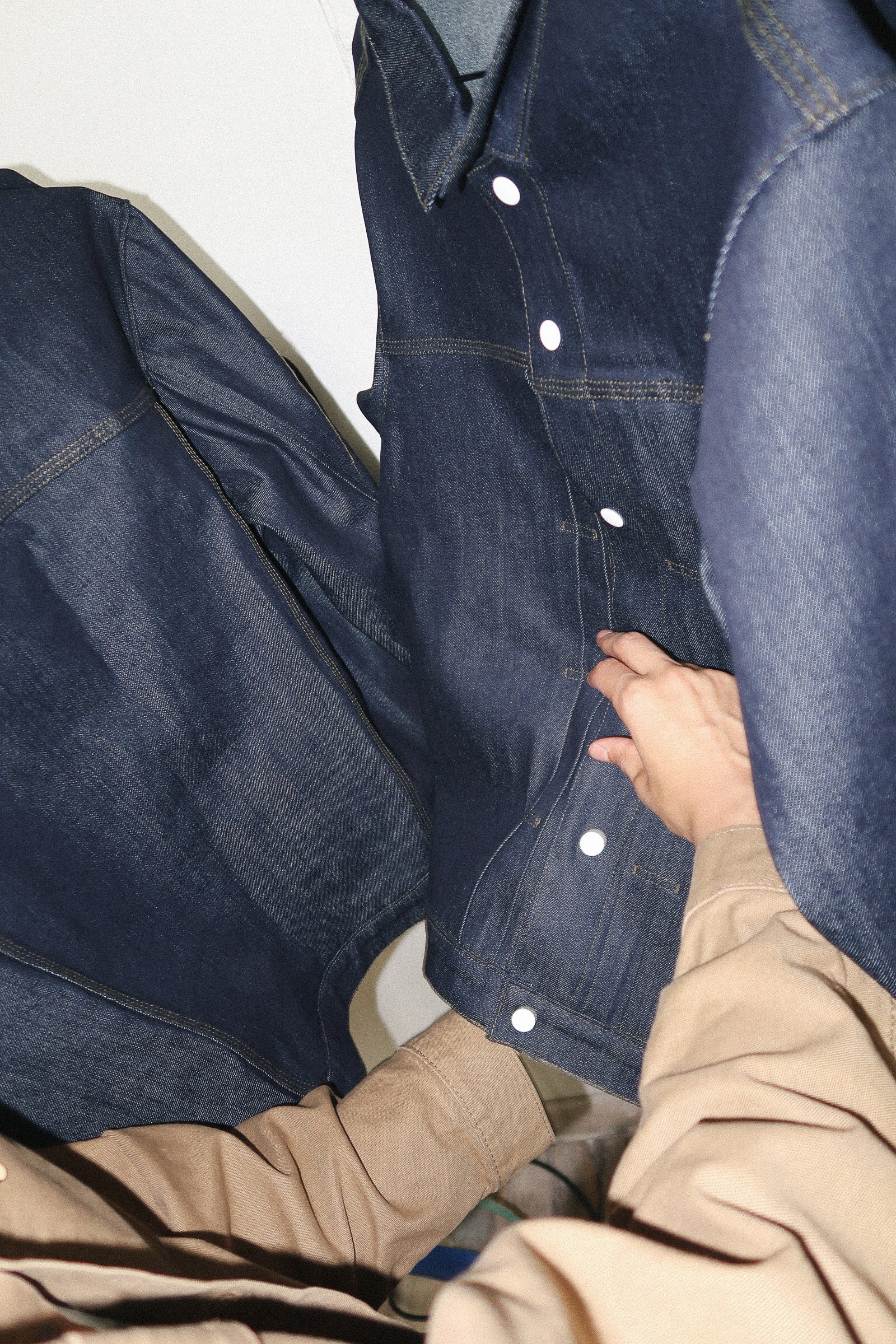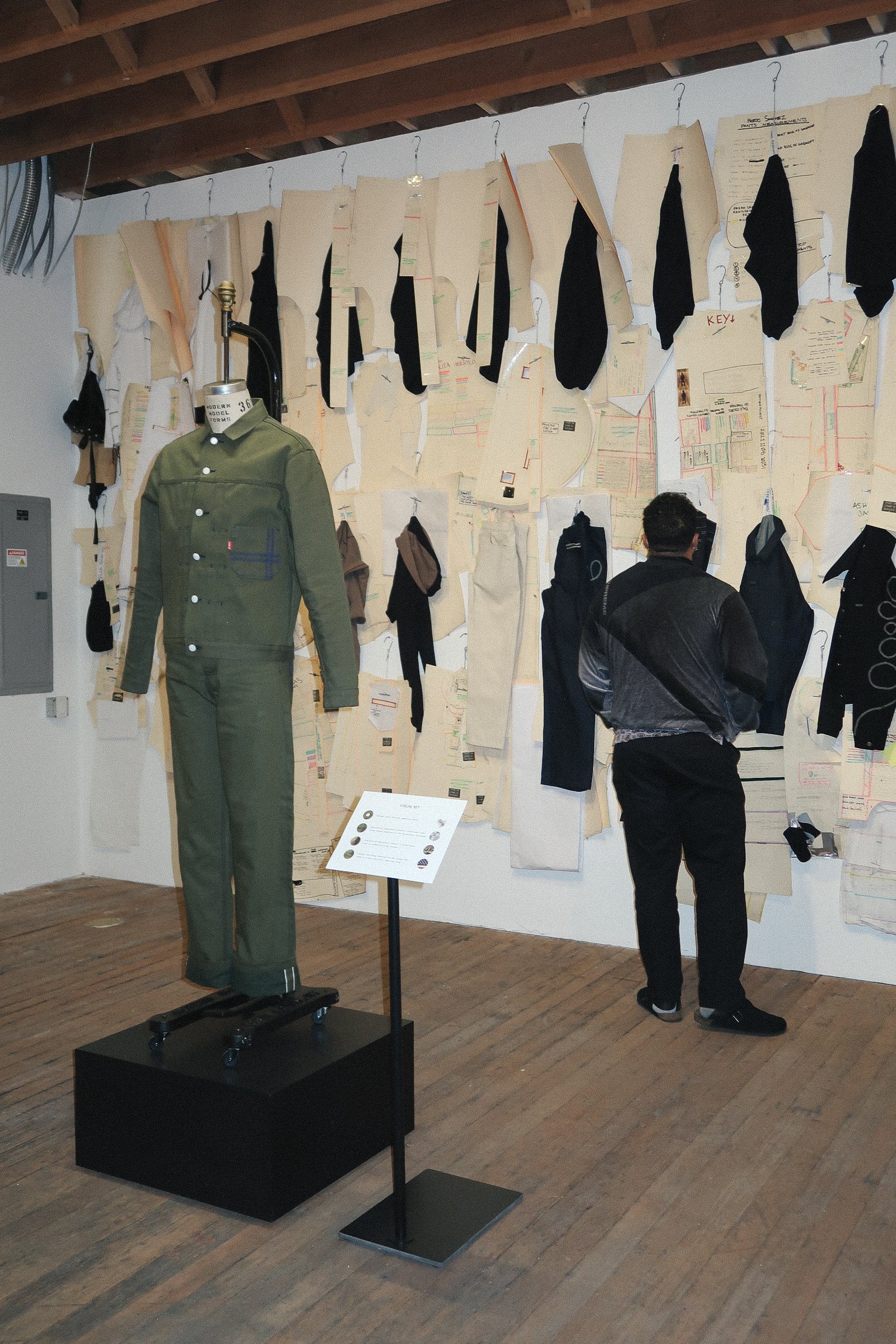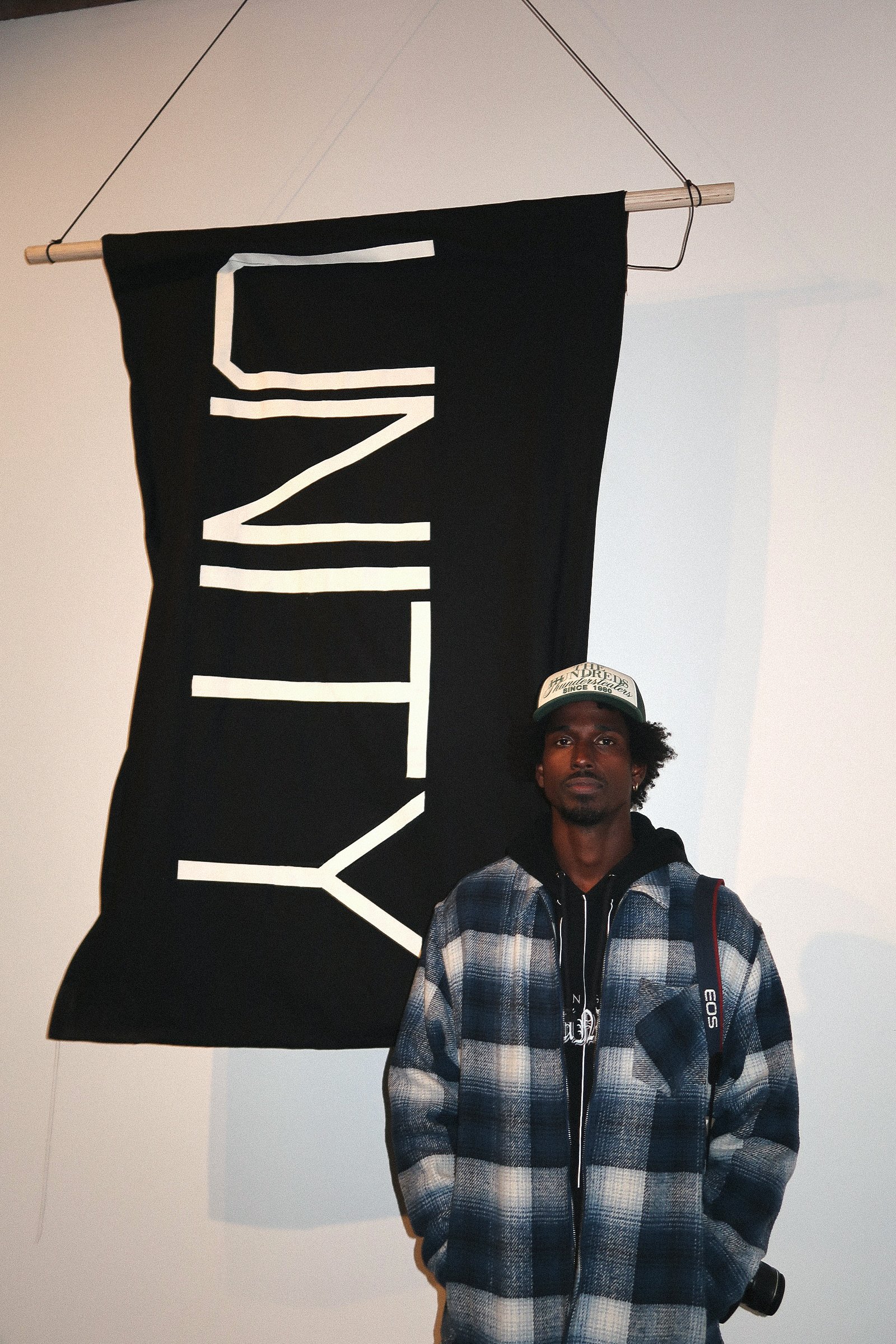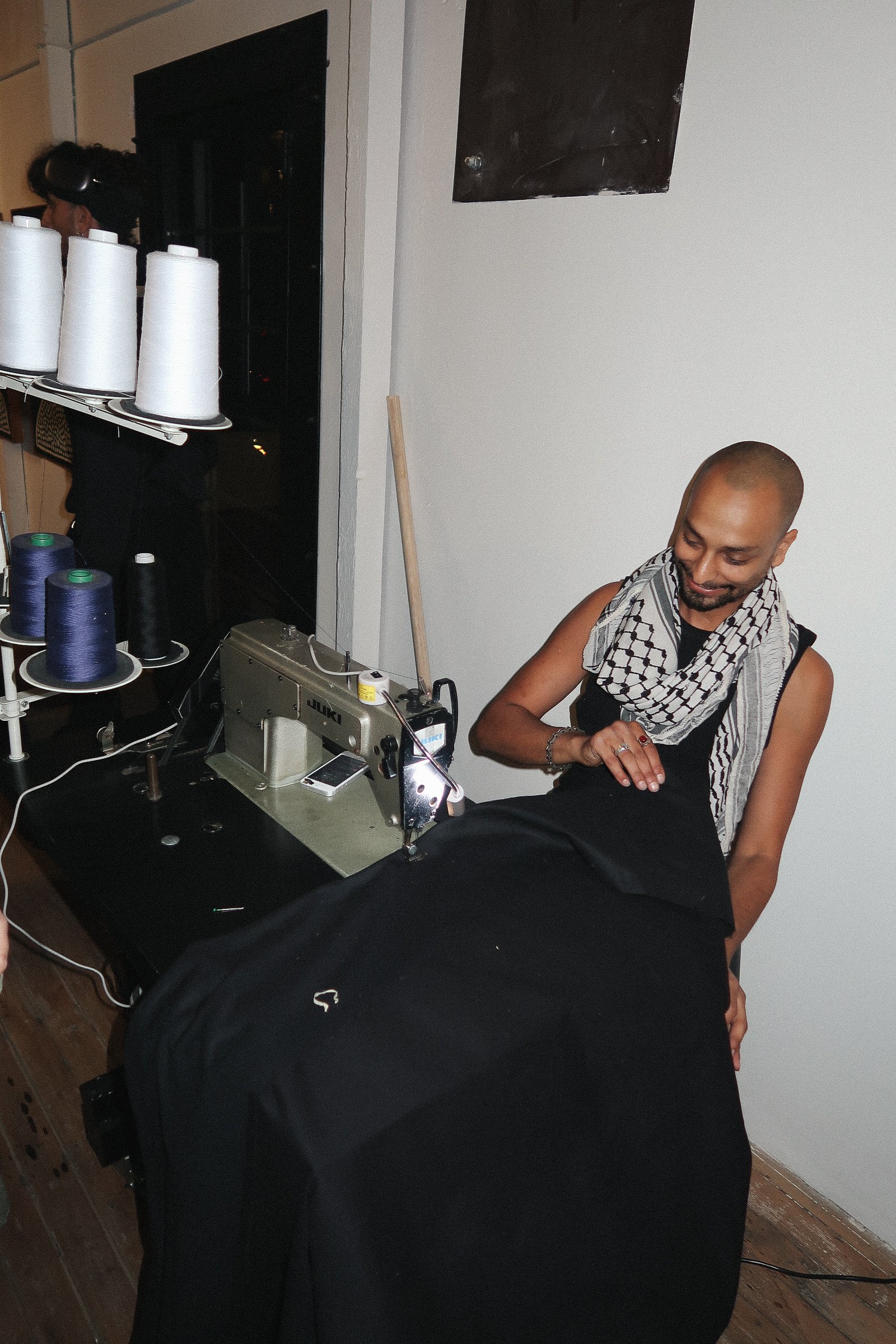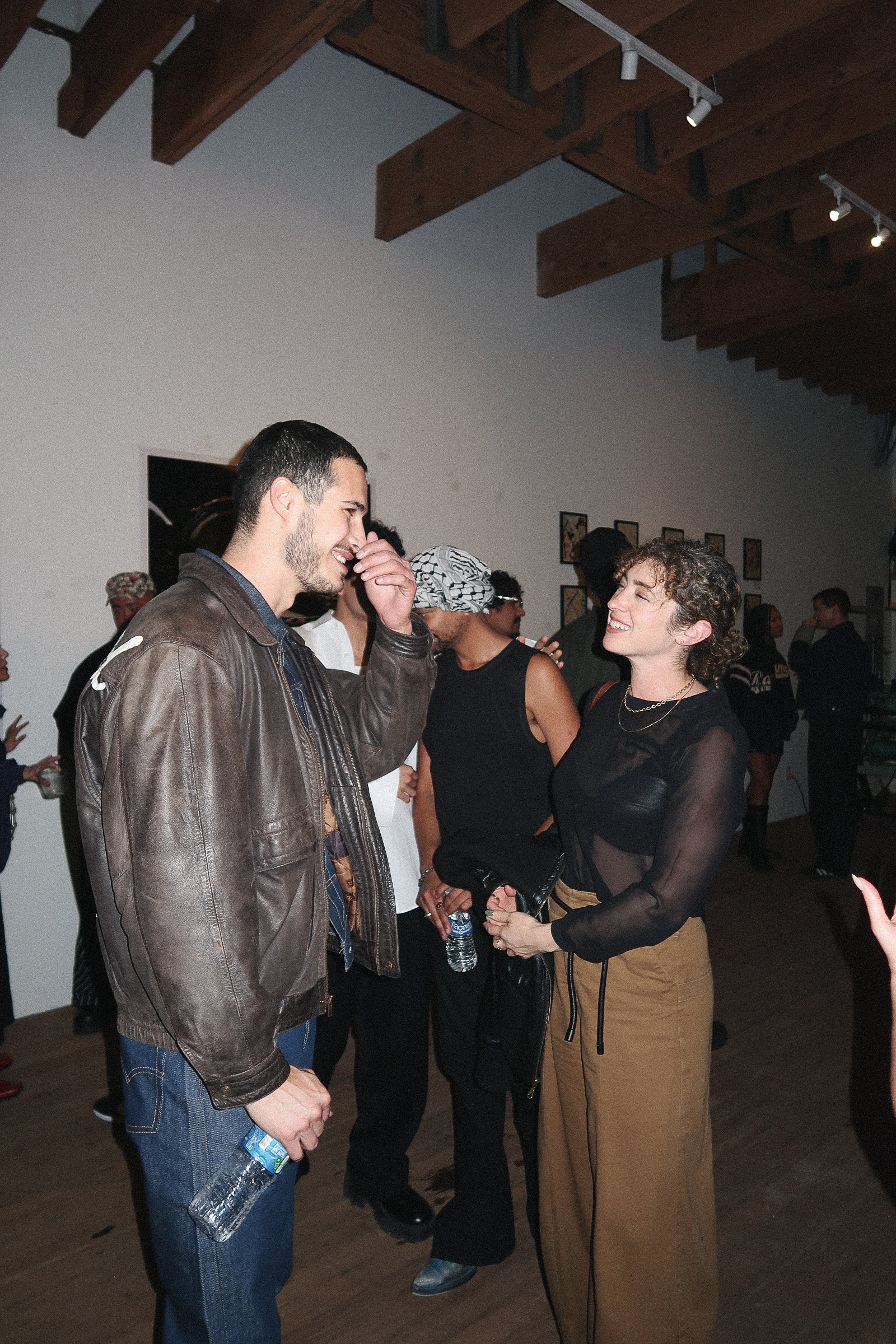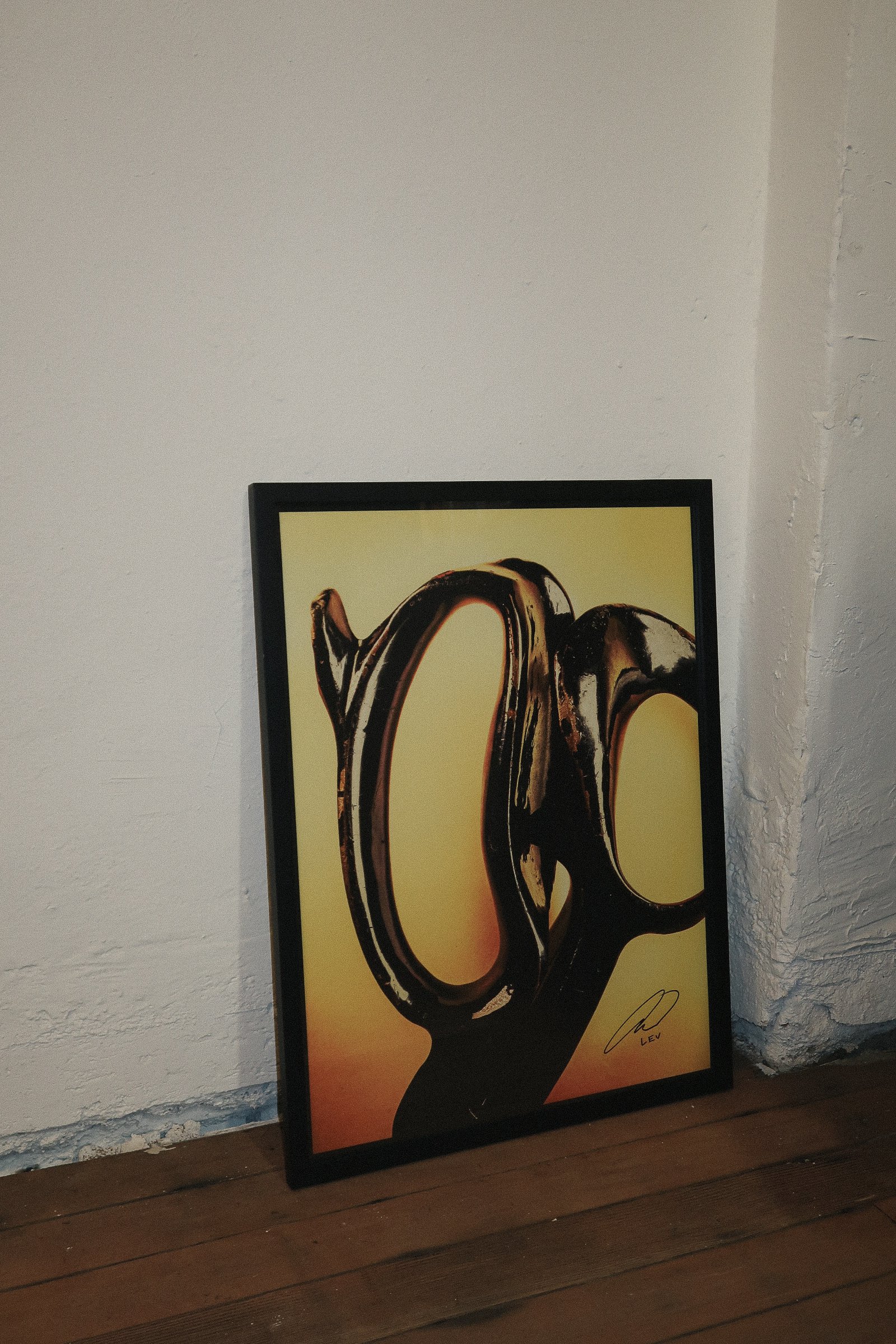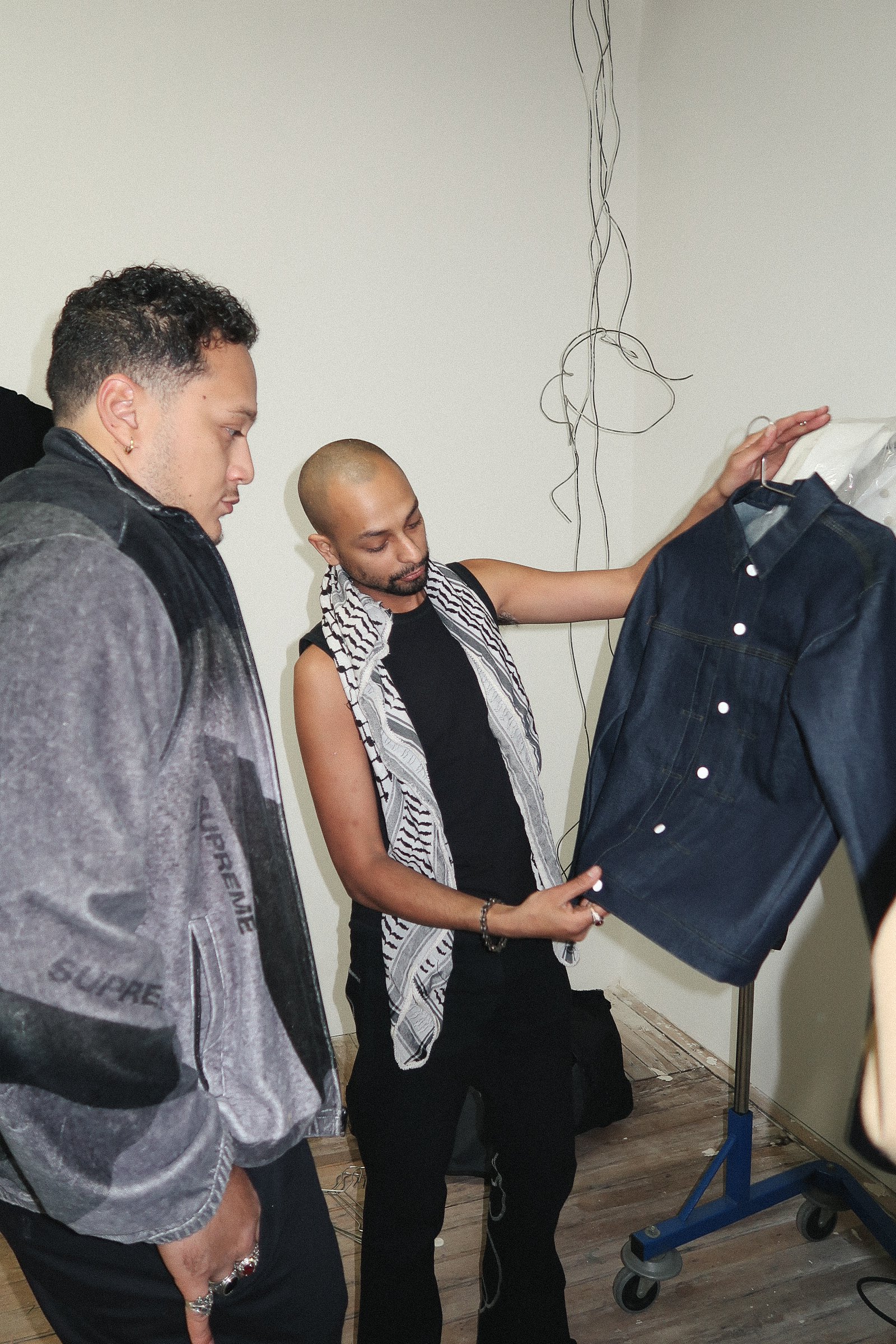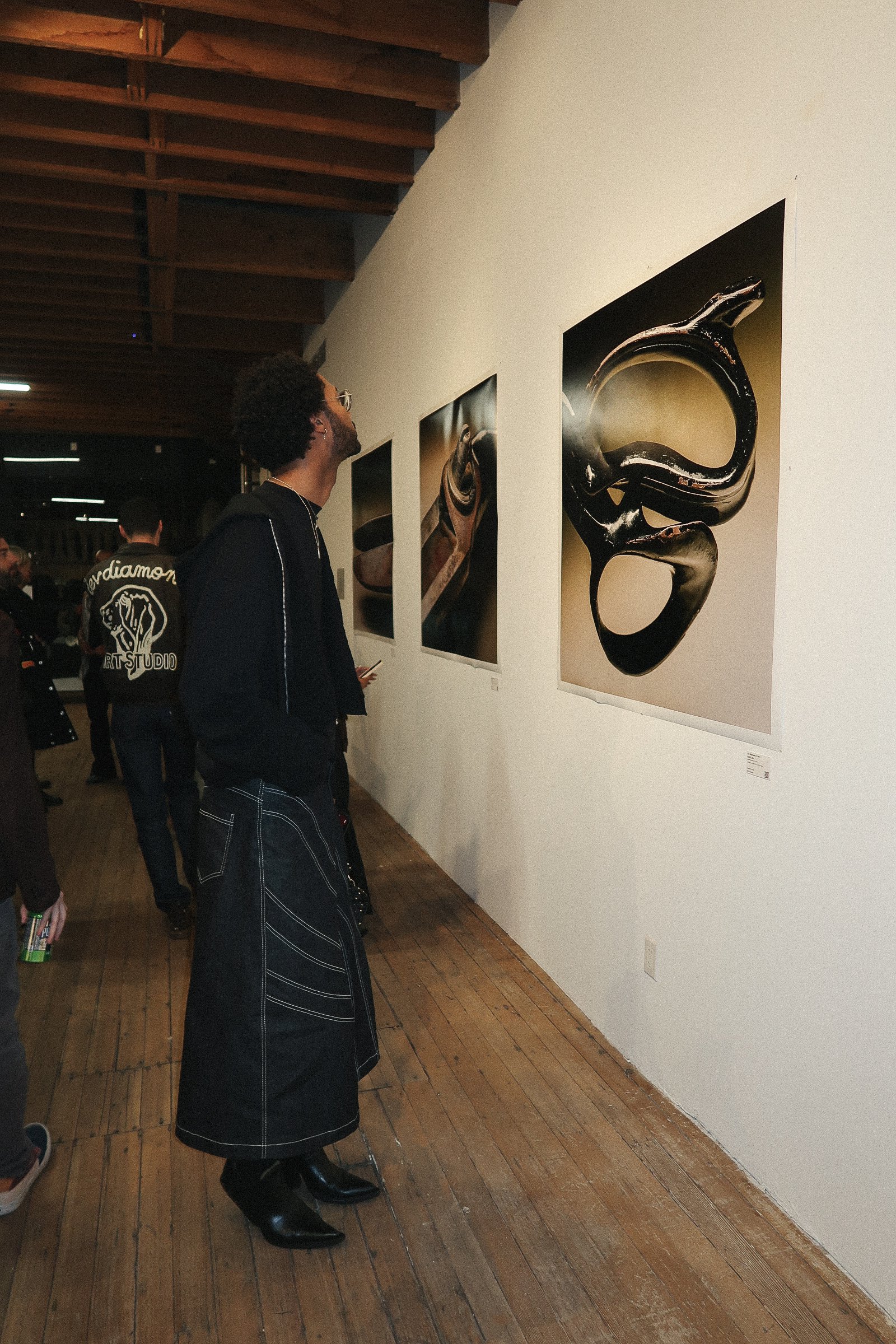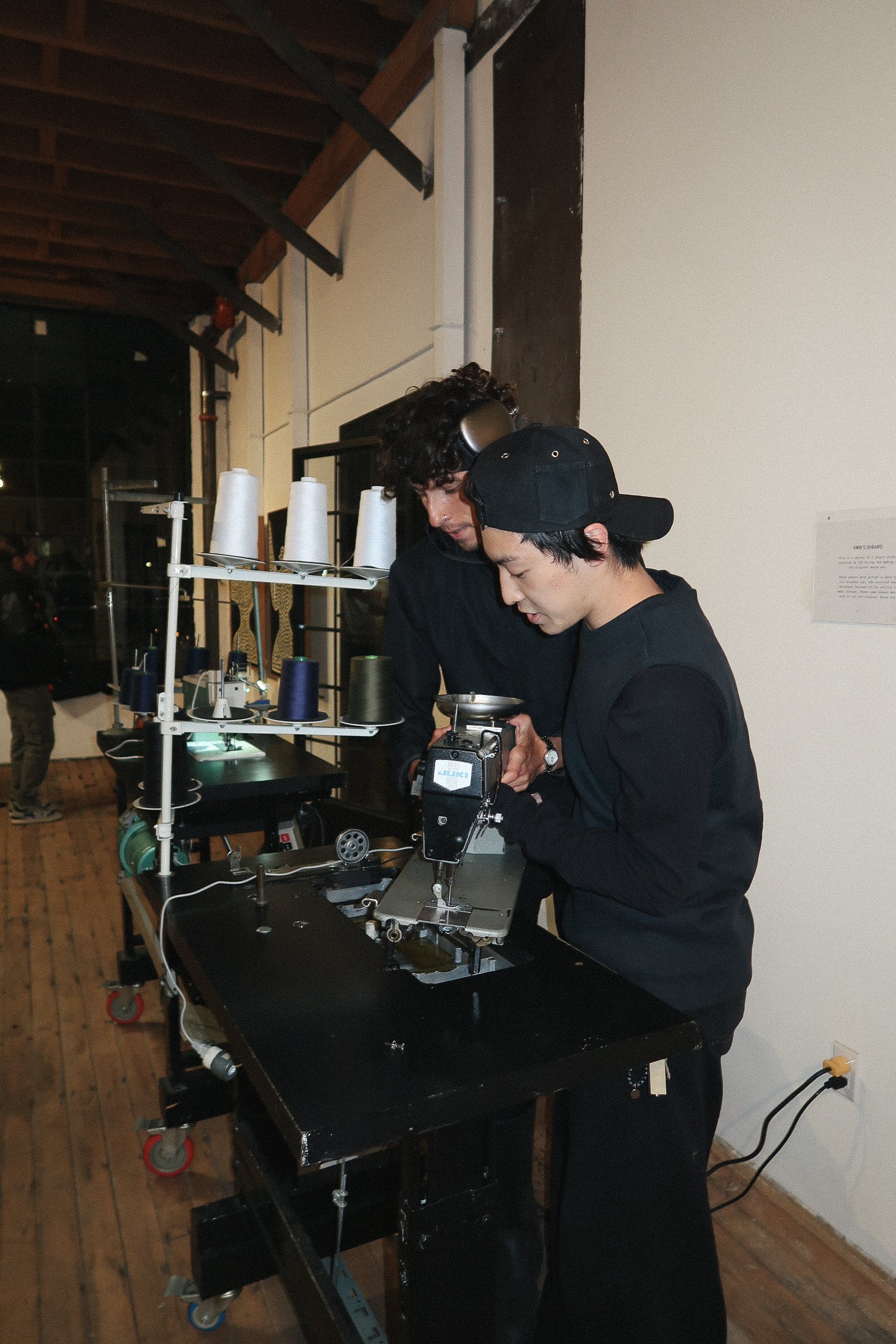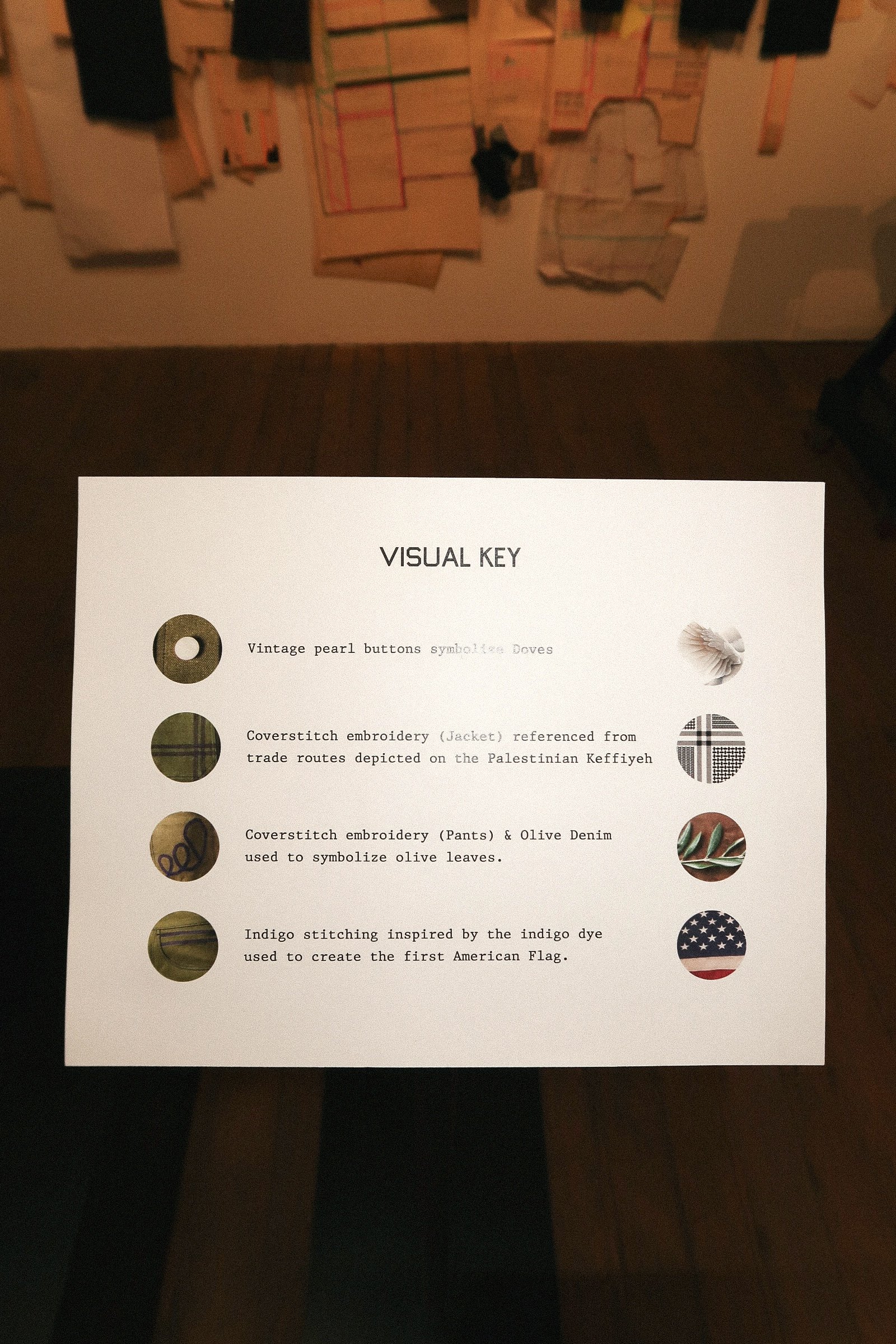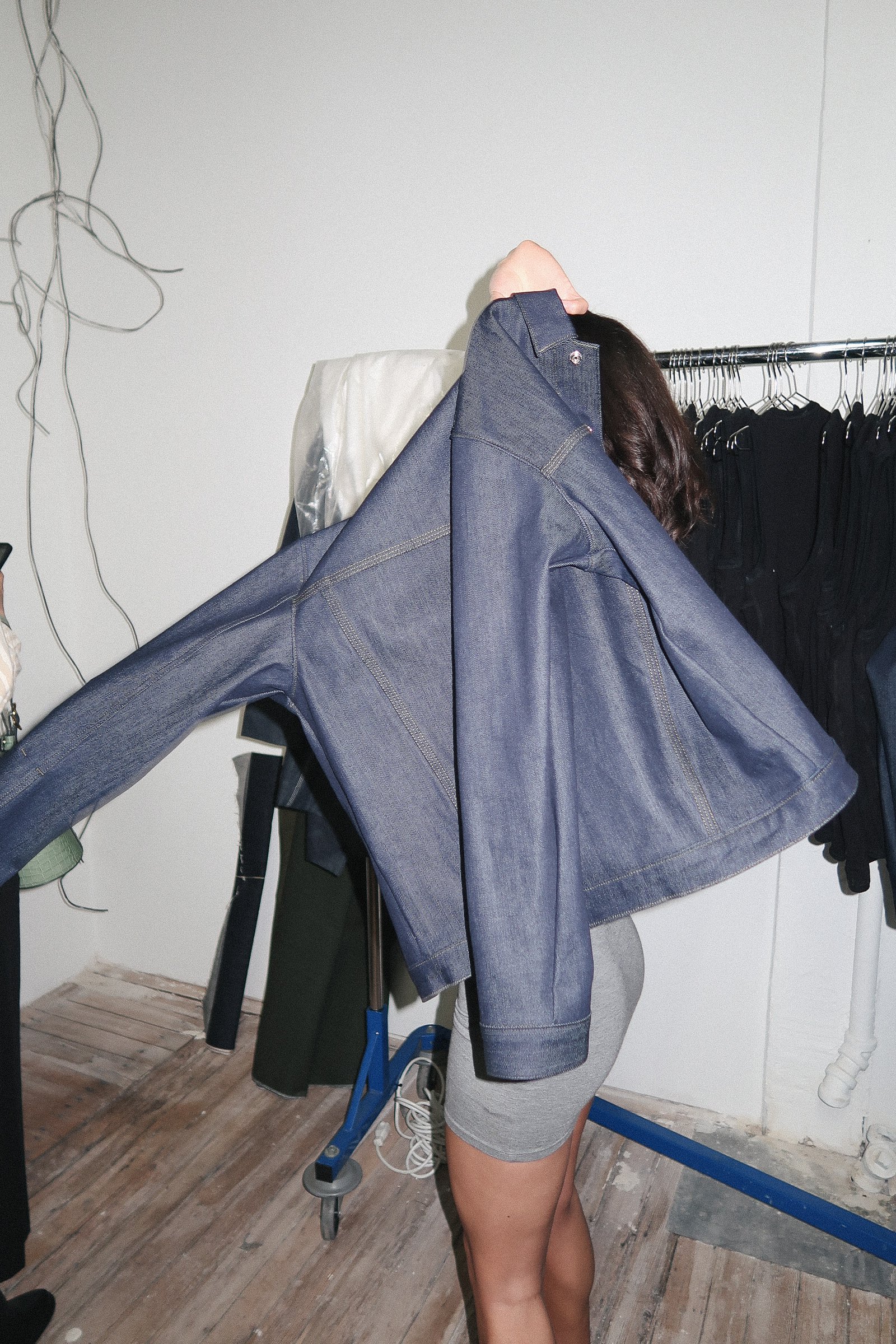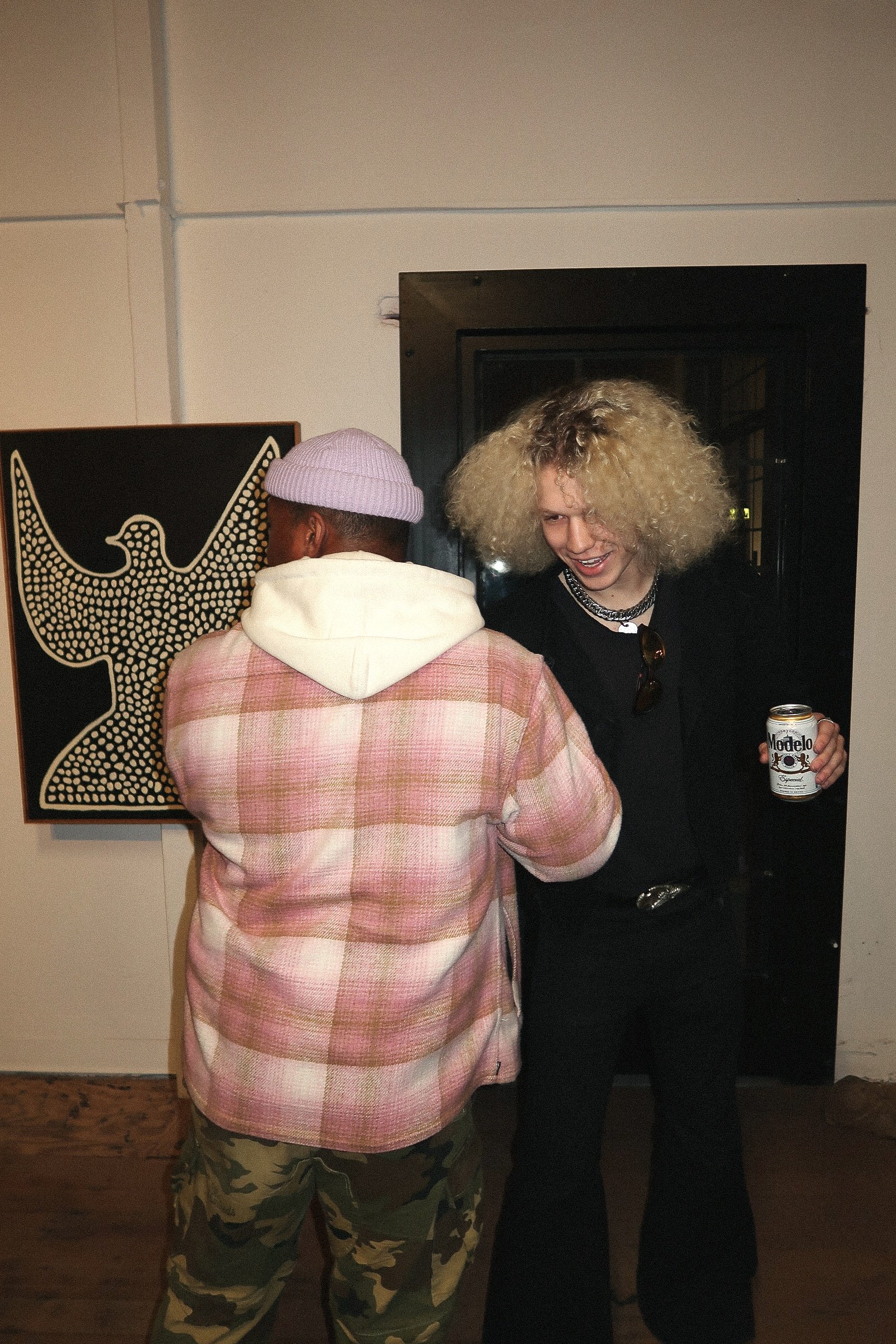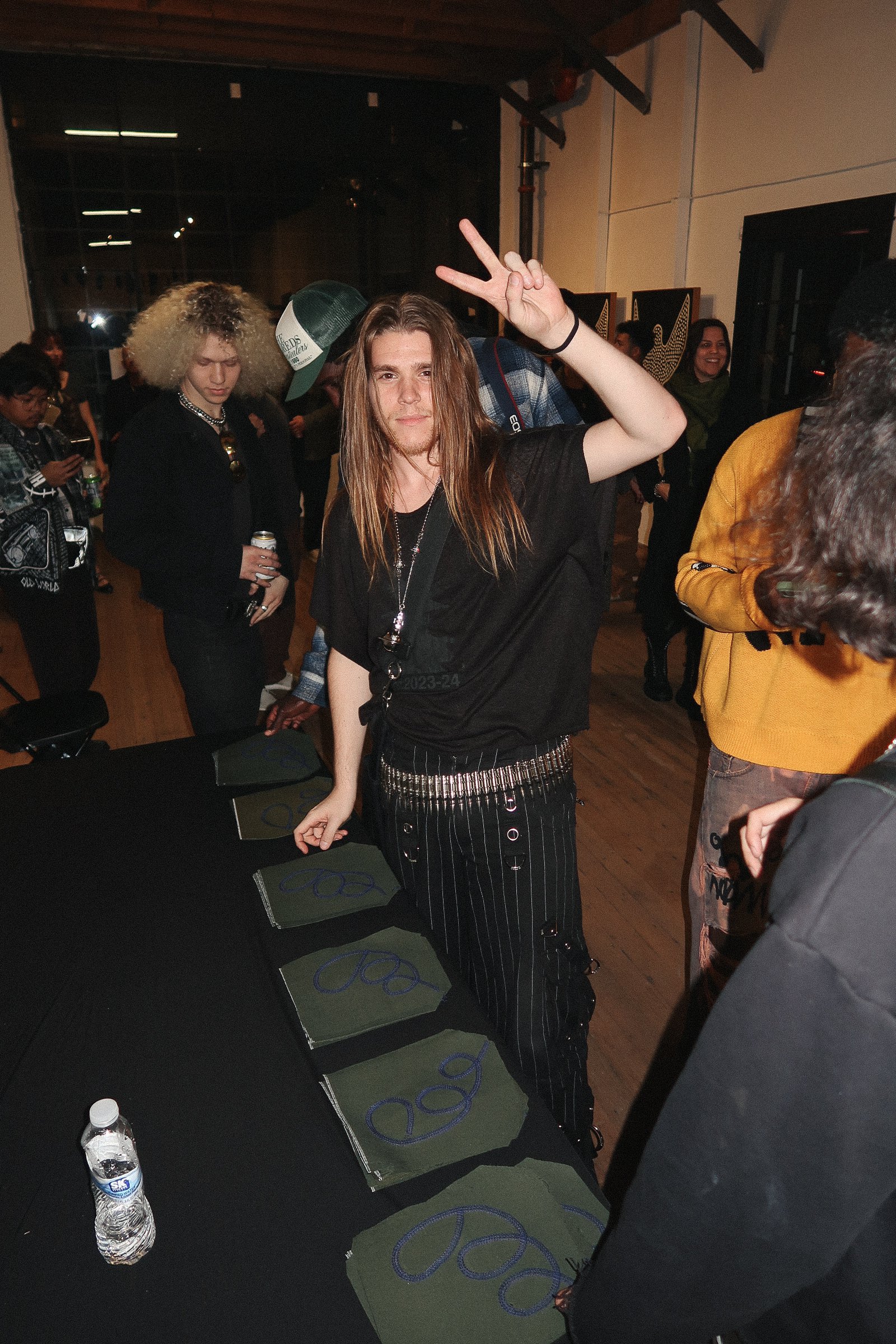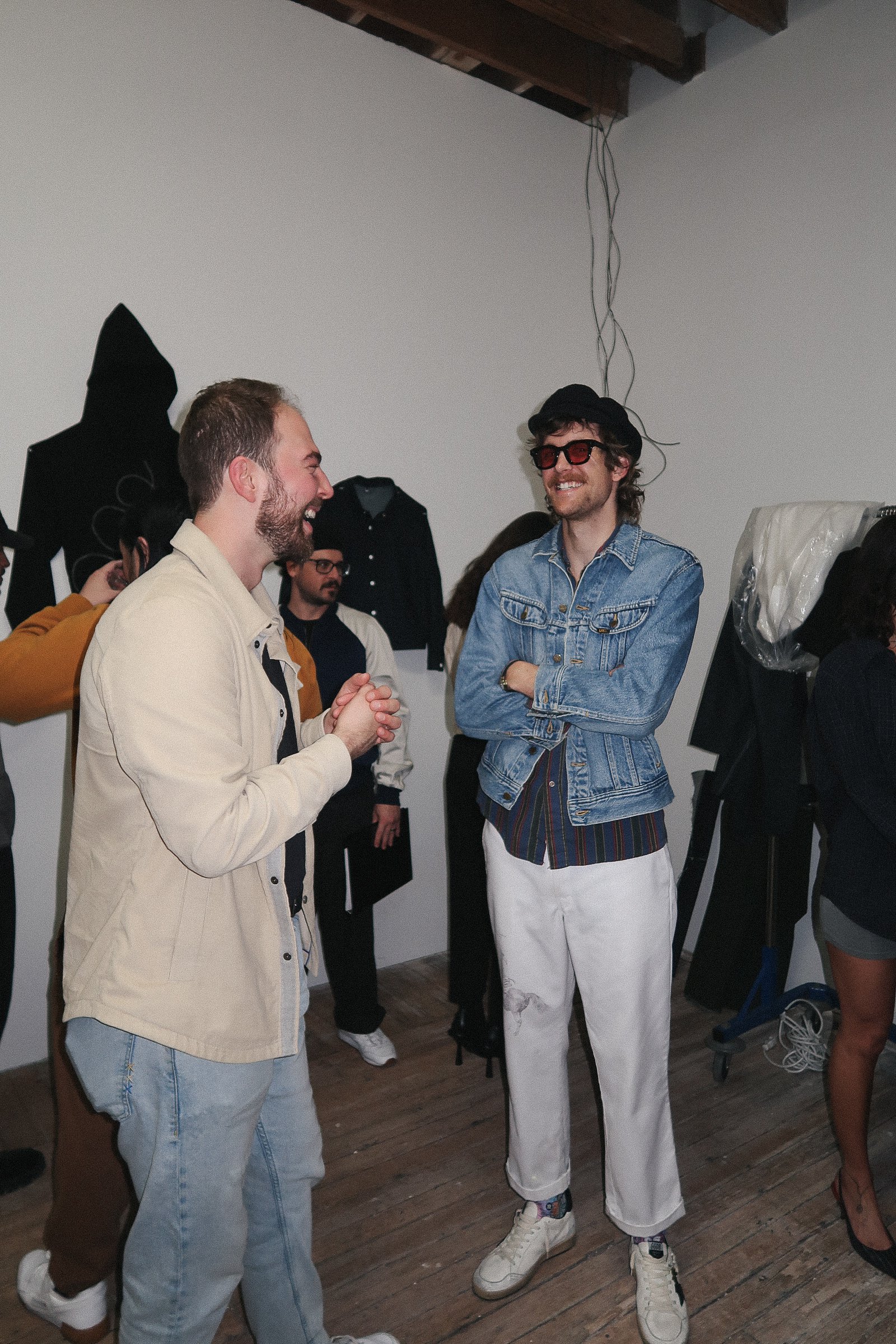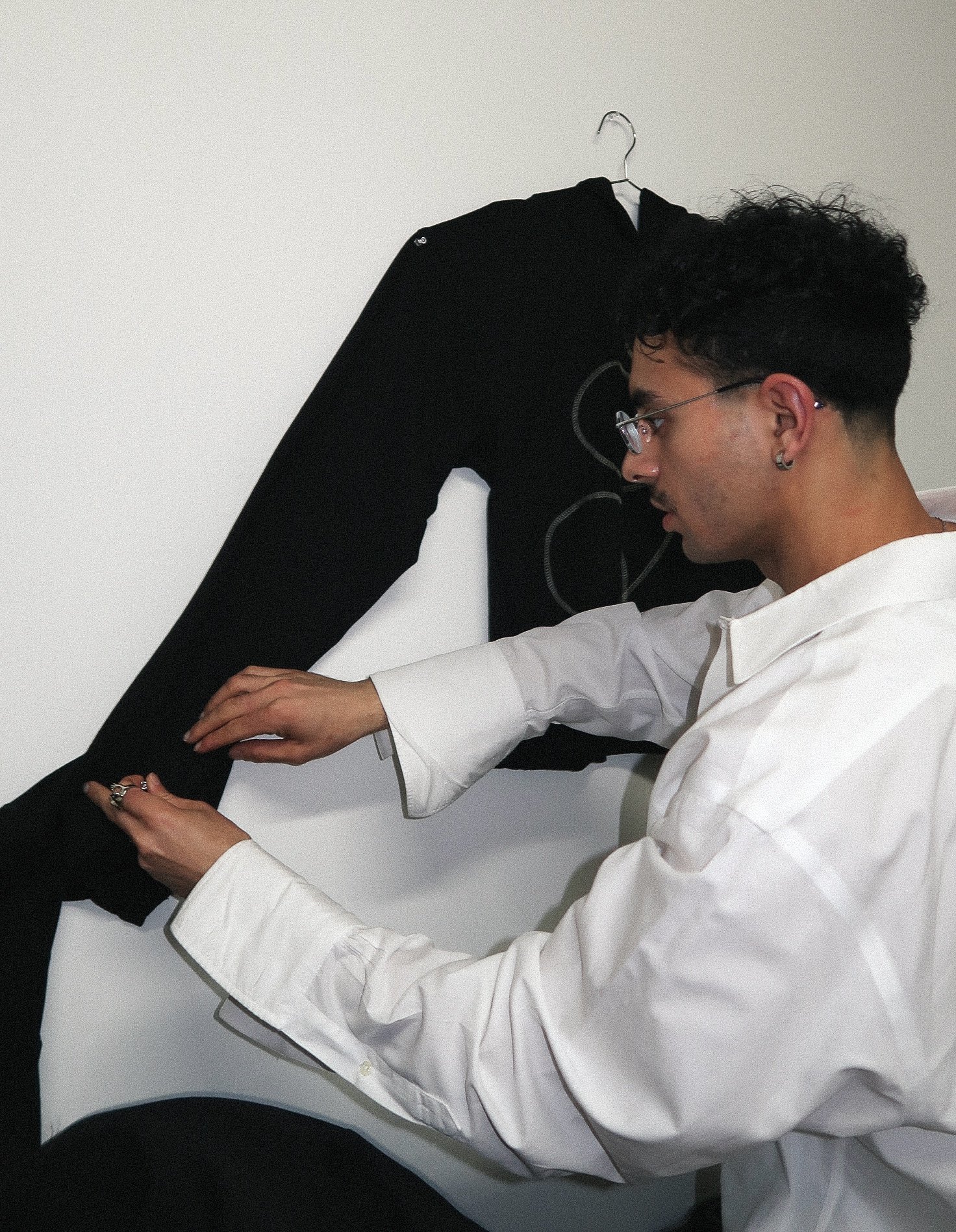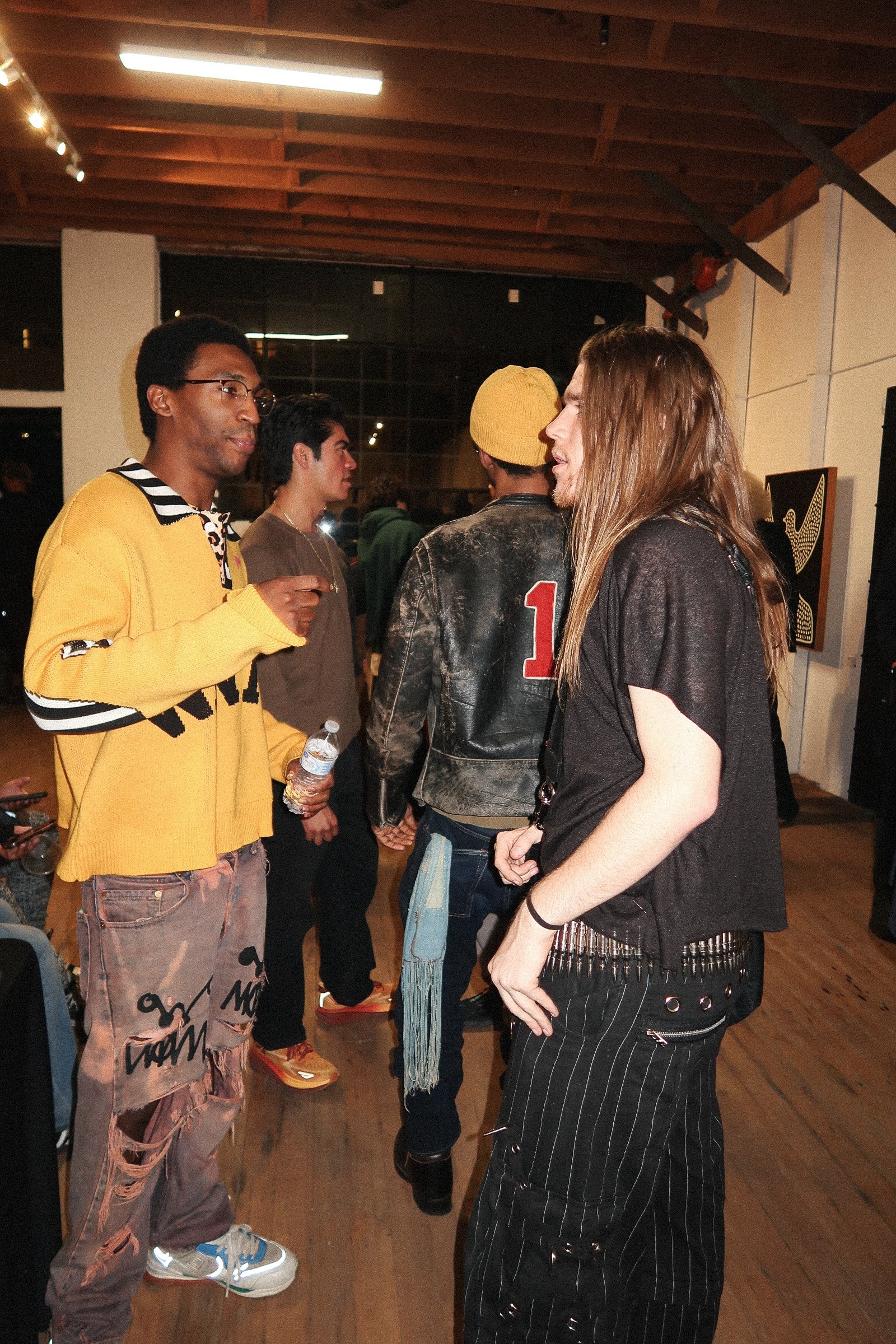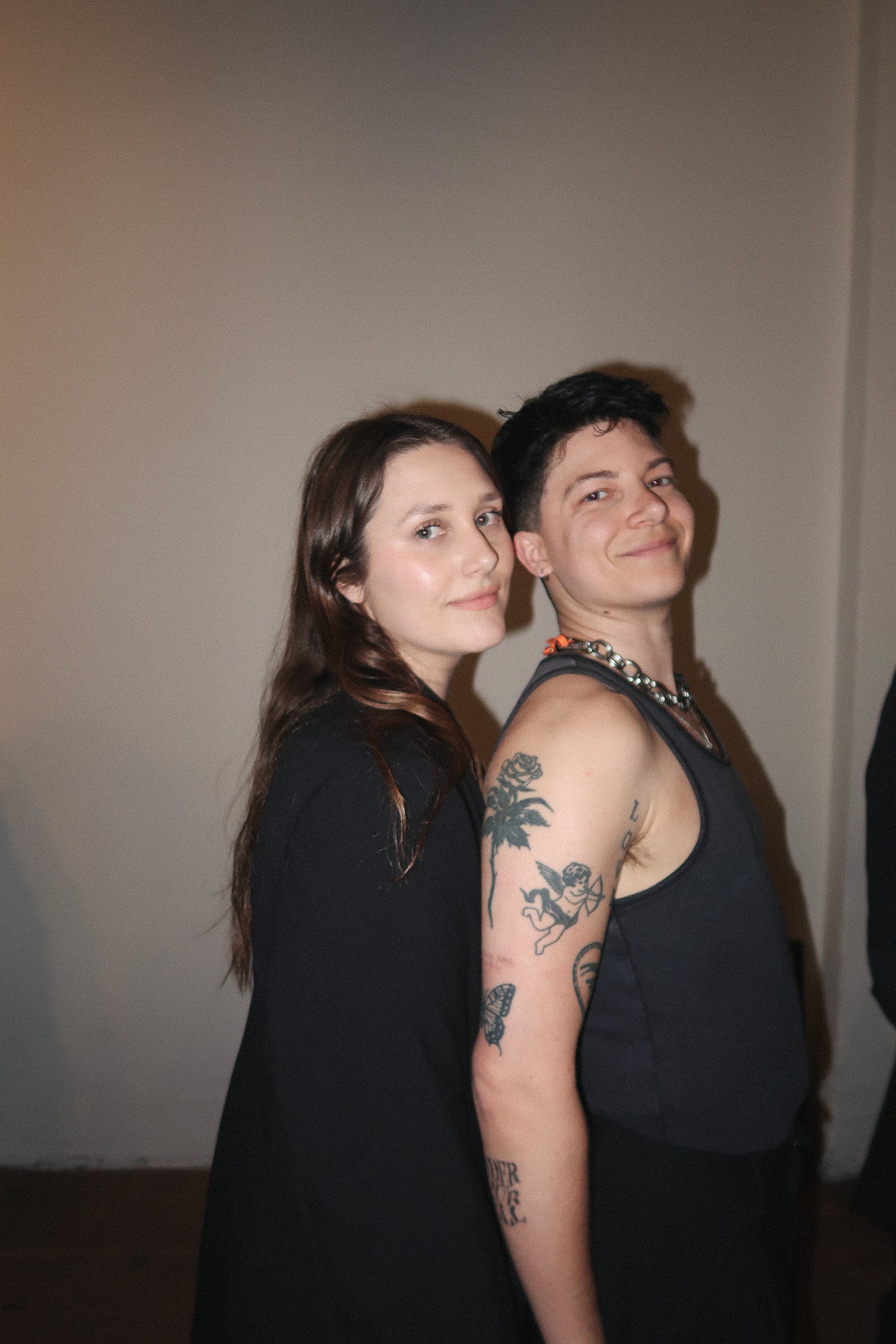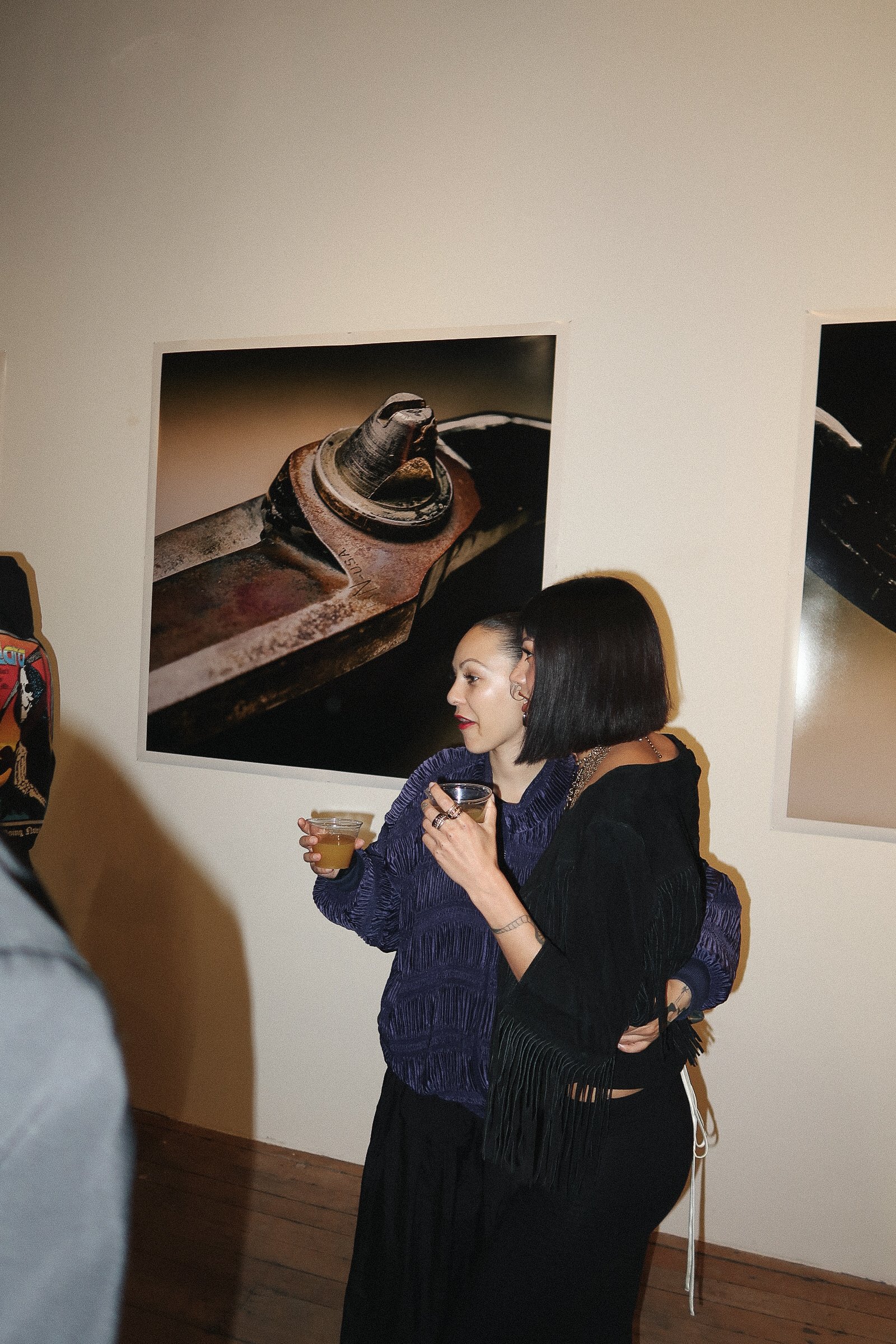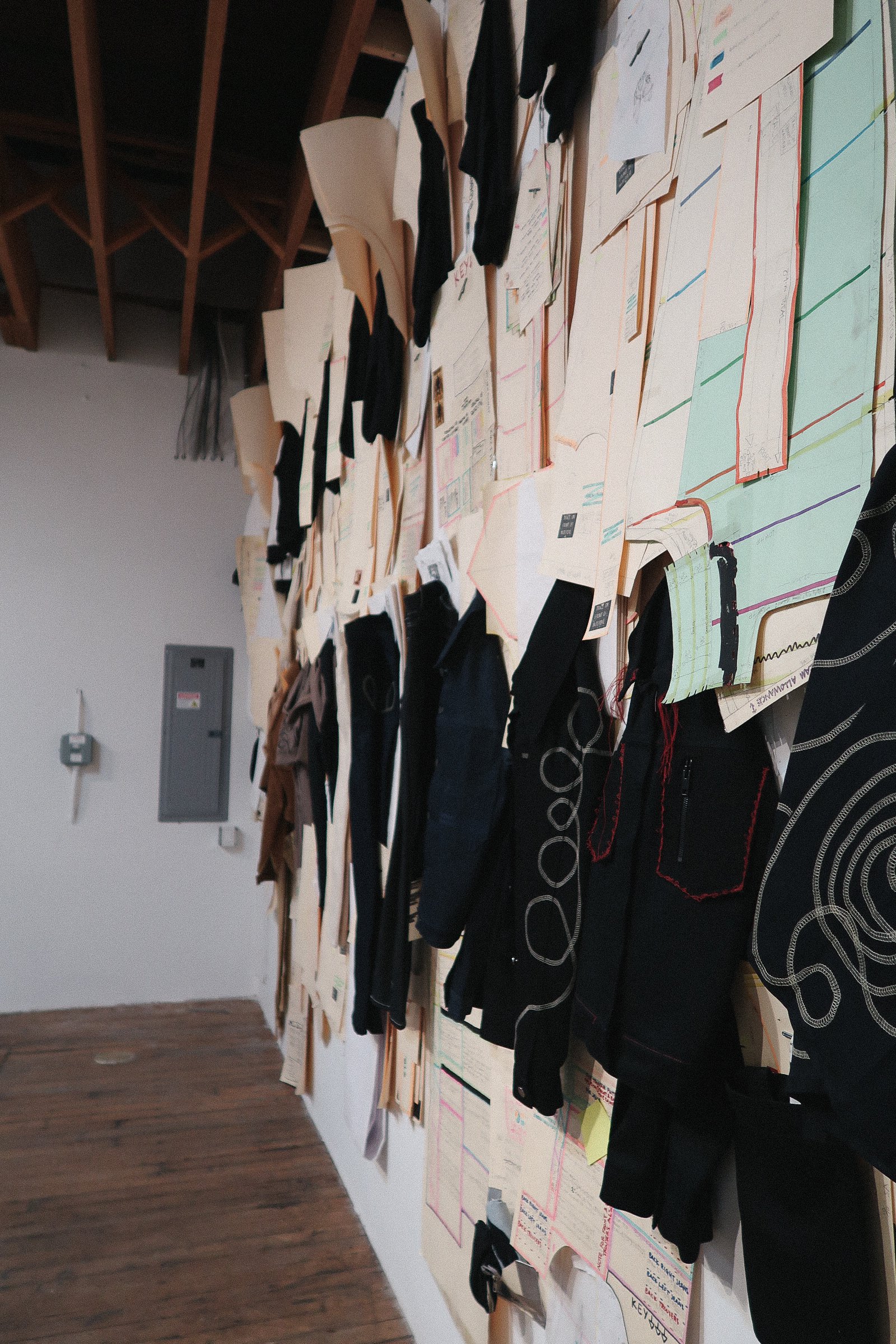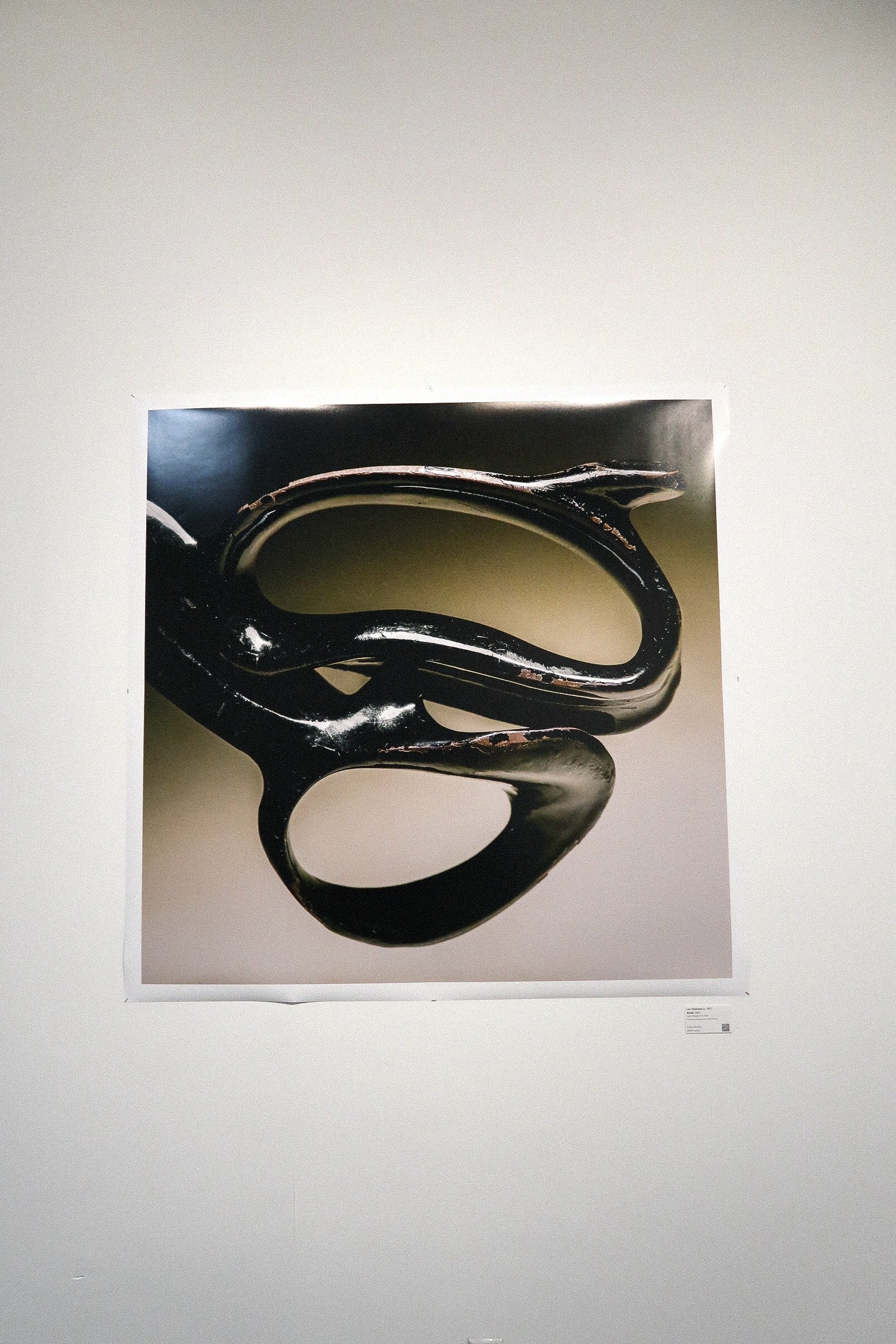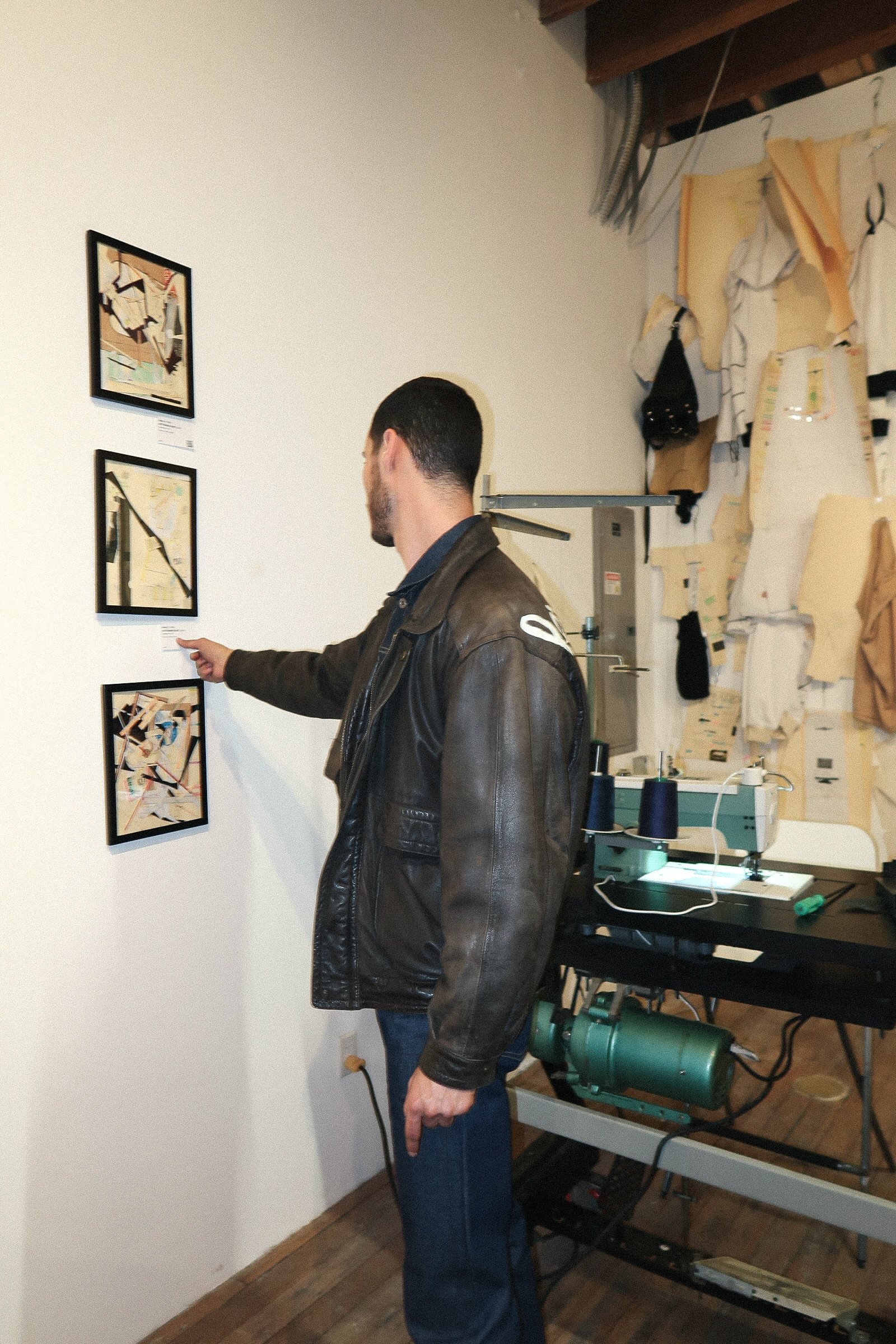CUT FROM THE SAME CLOTH - UNITY EXHIBITION
April 12, 8-11PM at 1634 W Temple St. - alabaster projects - donate
CUT FROM THE SAME CLOTH: in conversation with Lev Diamond and Amin, the artists behind upcoming LA-based exhibition, UNITY.
Interview by BROOKE AND BLYTHE TOKAR
Palestinian artist & fashion designer Amin and Jewish artist Lev Diamond aren’t political activists. They’re two artists trying to create a cultural movement by bringing people together and encouraging unfiltered conversation. The catalyst for this movement is their groundbreaking partnership in producing “UNITY”, an unprecedented eight-day exhibition that demonstrates the impact of communing and creating with one another over shared passions and beliefs. After the October 7th attack on Israel and subsequent humanitarian crisis in Palestine, Lev approached Amin for a bespoke piece and from there this artistic partnership came to fruition. We sat down with Lev and Amin to talk about their creation process and how transcending cultural divides is implicitly ingrained in their work. Whether through garments that are steeped in symbolism or heirloom tools that stand for more than their functionality and carry a deep historical weight, the revolution of their work is found in the way it illuminates the profound value of all human life and their anti-war sentiments. It’s their art’s ability to spark meaningful conversation that makes this exhibition so impactful as it drives challenging dialogue surrounding sensitive tropes that ultimately gives us the chance to learn from one another rather than fueling further antipathy.
You two came together to create this custom piece but that’s not how you first met. Can you both tell us about your origins and how you met?
AMIN
“I'm a self taught artist and designer - I like to put ‘artist’ before ‘designer’, because my pieces are generally more of an art piece than they are a commercial garment. I've been working for 10 years and have two design studios here [in LA] and in New York and am looking to expand internationally within the next three years. I realized I wanted to design when I was about 14 because I wasn’t seeing clothes that really spoke to who I was, so I just started making them. Around that time, I was diagnosed with cancer and was part of the ‘Make a Wish’ program - something I didn’t use until three years after my diagnosis. I felt like there were others who deserved it more and didn’t have a tangible ‘wish’ so I waited. Eventually, I took my designing seriously and used my wish to set myself on this path by asking for sewing machines, a computer, and to meet a couple of big label designers - 10 years later, here we are.
I'm mostly focused on denim and leather because of their wearing characteristics, as you wear these pieces, the actual wear and tear starts to show on the garment which I love because it gives a sense of the piece adapting to the wearer. That's the emphasis of my work, it's like a study on humans using clothes as the catalyst. This is one of the reasons that Lev came to me - he wanted something that told a story.”
LEV
“I’m also self taught, although in multidisciplinary art and photography. My first job was at a sandwich shop in my hometown and I honestly hated it so much that I told myself I was never going to work doing something that I didn't love. So I used all the money that I had saved from that to buy a camera and taught myself off of YouTube, basically everything that I needed to know to start taking photos. After that I was taking portraits and going to college for communications and graphic design until I was hired for my first freelance design project for the President of the Women's Caucus for the Arts in DC, helping her design a blazer that she would wear to a gallery exhibition. That was my first stepping stone into fashion, and something that I didn't really expect. From then I was always interested in fashion and looking for a way to work in that space.
I first met Amin when I came to LA, and went to a gallery event wearing a full denim, Canadian tuxedo. He walked up to me and commented on it, inviting me to his studio after our conversation. A few months later, I found this jacket at a flea market that was damaged so I stopped by his studio again where he offered to repair it for free. During that time, he started to speak about the shears that he had and his background as well, which I wasn't really aware of at the time, and we had a more personal conversation. Six to eight months after that, I decided that I wanted to do a custom denim set and the first person that came to my mind was obviously Amin. The timing of it was really important because of what happened and was going on in the world.”
How has the timing around the war and the subsequent humanitarian crisis translated in your physical art space?
AMIN
“A lot of my clients here in LA and New York are Jewish, just a lot of neighborhood people that are into clothes and wanting bespoke pieces - just like I was. When everything happened in October, people who I’ve known for five plus years disappeared; they unfollowed me on Instagram, blocked my number, won't even say hi to me in the street. Despite the racism and prejudice, Lev came to me in November specifically because he wanted to do something in the face of that, so that really spoke to me.”
LEV
“Yeah, and I think, we look at art very similarly, even down to our signatures, we both have a very similar signature stamp going on that showed us this kind of initial parallel to our work. Going off of what Amin said earlier about creating pieces that wear through time, I think, not only that, but many other things we share an appreciation for. One of our main focuses is creating things that live through time and appreciate as they age. There were so many things throughout this process that we were just clicking on that I think was really special.”
You’re both speaking to wanting the pieces to appreciate through time and seeing art in the same way. I was wondering how that translates into how you chose the symbols that are part of the piece and what those mean and represent to you, especially considering the lens through which you are creating?
AMIN
“I think for me, they're all symbols of Palestine, peace, and freedom.”
LEV
“There was something so special about this where it was really when we started to click on the art direction. For example, when choosing denim, Amin talked me into going with an olive color, rather than a traditional blue, and we discovered this is what we were going to use to symbolize the olive leaves that represent peace to us. Denim is also just a very American thing, a motif throughout American history, and, as we both live in the U.S., we wanted to make a message that was palatable to the American public. We found ways to integrate this American sentiment into every detail down to the stitching, which is the same indigo color that was used to dye the threads that made the first American flag.
Then we began to find other design elements where we could bring in the symbolism that we were trying to communicate: special pearl buttons were added to the piece to represent a dove and his signature cover stitch embroidery, which is like, traditionally loopy, represented the keffiyeh (a traditional Palestinian scarf). It all started to fall into place, yet when you're designing clothing, there are a lot of elements to consider when thinking about clothing as a catalyst for communication and I think both Amin and I have our own personal artistic limitations on what we want to produce.”
The idea of communication - artistic, verbal, written - all seem very prevalent in both of your lives and creative processes. Could you speak more to the process of your ideas and your communication being shifted into more of a visual space?
LEV
“I really think that designers are like architects of language. Every time a graphic designer makes a poster or designs a brand system, they're essentially assigning meaning to shapes, colors, and images. So in my mind we’re essentially building a visual language of our own that people are able to not only learn, but also interpret immediately, in a split second.”
AMIN
“My golden rule is I don't create anything with words or graphics. Whenever I'm creating anything, I want the piece to be able to stand in a museum, so I think from that perspective and then go backwards. In my mind a museum is the final resting place for anything I’m working on so I like each person to be able to make their own perspective or decide what my piece is communicating for themselves.”
LEV
”That was a really interesting experience for me because I work full time as a graphic designer. Graphics are my language so there was a very heavy contrast there where we had to find a balance and figure out how we could engineer this to work with everybody.
What I've really learned from other artists as well, is that a lot of art is created without an initial plan, and then it's kind of reduced and reverse engineered until the meaning is understood. For example, a painter might paint a picture of something, and then they might look at it two days later and understand why they painted what they did. One of those moments for us was choosing the denim that we used. Amin just happened to have a roll of it in the studio while we were considering traditional blue denim and the choice just made sense, although the meaning would reveal itself to us later.”
This cross-cultural communication and work style seems to be the foundation of your partnership - were there other moments where you felt especially connected through the work or other nontraditional methods of communication?
LEV
“The first time I heard the story about Amin’s shears that he inherited from his neighbor, a Holocaust survivor, was something that deeply resonated with me. I know that currently, there aren't too many Holocaust survivors living right now because they're all getting very old, they're just a rare group of people. Luckily, I have met a handful in my lifetime, but still very few. So to have an object or a tool that you can use every day in remembrance of somebody and their history, as well as the history of that atrocity, I think is really powerful.
When we were photographing, capturing the shears, we really wanted to put an emphasis on just getting as much detail as possible. I think in the same vein that we believe that the wear on the clothes tells a story, we also believe the same thing about the shears as well; every scratch and crack and crevice has a story to it, so we really wanted to capture that in the finest quality possible. We chose to print the images four feet by four feet in a triptych style, enlarged as huge prints so you can stand right up to it and see it from a sort of magnifying glass perspective. So I think hopefully, the magnitude of them will translate in the gallery.”
Amin, could you share more of the story behind your shears and the man you inherited them from?
AMIN
“Leo was my neighbor when I first moved to LA’s Fairfax District. He was a 92 year old who had a reputation for being a hardass but when we met we immediately hit it off. He moved to LA to escape the Holocaust and made clothes in order to make a living for himself so we had a lot in common and shared experiences. He’d come to my studio and hang and sew a hat or a jacket, or just repaired something using his shears. I knew his shears had a special energy to them because Leo used them throughout his life, so when he passed them down to me they immediately became one of my most treasured items.
The shears that a designer uses are sacred, most designers don't let other people touch their personal ones. So that added another meaningful layer to them since he willingly parted with them. I use these shears truly every day when I’m in LA; I can’t travel with them and have yet to find another pair that cut as well or feel as natural in my hands - it’s impossible. These have truly become my go-to tool and have maintained Leo’s sacred energy in them, something that I hope comes through in my own work.”
Your connection with each other is felt in the intentionality behind the exhibition, as so much of it is rooted in your common positioning, especially of being anti war. I think we all have an understanding of what that means for ourselves personally, but what does that sentiment mean to each of you? How does this sentiment show up in your work?
LEV
“To me, it means valuing human life.I don't think war values human life at all and understanding and educating yourself is an act of anti war. I personally don't believe in true evil. I think every time I hear the word evil come up, it really diminishes whatever point has been made, because I've personally never seen true evil. I only believe in ignorance, greed, and anger and think all three of those things can cause violence, but I think evil is a myth. I think that kind of mindset, to me, is anti war, because I think that brings some understanding to perspectives.”
AMIN
“I think that for me it means equality, freedom, and peace, but also being anti the military industrial complex; being that it’s one of the most profitable industries in the world, anti war means dismantling a lot of things. I'm an artist, I specifically chose to be an artist, I didn't choose to dismantle systems and sometimes that decision eats me because it's a real gamble on yourself and your belief system. However, you have to maintain the belief in yourself to be able to change the world in whatever way you want through your art.”
How do you feel like your feelings and reflections about anti war are reflected in your personal life, art, and connections with people?
AMIN
“I think just how I live is a reflection of anti war, even choosing to be an artist. One of the first things that I tell people is that I'm Palestinian, and the response is either ‘Oh, that's so political’ or it's ‘Oh, we love you guys, come on in.’ Being able to have those experiences, where just saying my ethnicity is enough to trigger somebody into actually attacking me, whether it be physically or verbally, is very illuminating and impacts how I want my work to change these ideals.”
LEV
“One way I implement being anti war into my life is through my belief that there isn’t one single truth. I think everyone either holds a truth or they share a truth with somebody, but there are many different truths that people hold. I think just acknowledging that, and understanding that what you might find to be true, someone else might find to be false, and just being able to hear somebody and listen to their perspective, is something that I'm always willing to do. I think that the world has become quite prescriptive, in a way, especially through social media, so I really try to listen more than I speak and not prescribe my opinions to anybody when I'm entering a room of people that I don't necessarily know.”
Do you see the exhibit embodying this where you're encouraging people to witness their own truths and maybe find a different lens to see that through? How do you hope that people witness you both and your art?
LEV
“I think we're hoping that people can comfortably share their truths, and then also receive truths that might not be in alignment with their own. Creating this safe place is something that we're focused on, promoting open dialogue and unfiltered conversation with the goal of learning and expanding perspectives.”
AMIN
“Yeah, absolutely. I think that in America, free speech is already interlinked with our constitution; they can't take it away from us so they're trying to take it away through social taboos. What I'm very big on just in my personal space, in my personal life, is unfiltered conversation. And that's why we're trying to make sure that is being catalyzed by the art and the space in the gallery, because you don't really get to work through anything unless you're having an unfiltered conversation. If you're having a filtered conversation, then you're not really expressing the ideas in your mind. I feel like the harder conversations are typically the ones we learn the most from which is why I'm very big on it. That’s why we make sure that people are having unfiltered conversations, or at least making the space available to have unfiltered conversations. I think valuing all human life equally, is also a big step. I think that that's what's missing, especially during wars.”
I think having people inhabit this gallery as a safe space will absolutely encourage unfiltered conversation, especially considering all of the elements to the exhibit. Can you speak more to these other elements and significance of the pieces that will be shown in tandem with the denim piece?
AMIN
“The exhibit represents the unsung stories of people living in unity cultivated through our art and creation. The denim set will be on display flanked by the original sketches that I did, as well as the patternsscraps of the pants and the jacket, which are like the blueprints for the clothes, as well as additional scraps from other pieces I’ve designed. The whole point of patterned scraps is to sit there and ask the audience, ‘where does the value lie for you?’ Does it lie within keeping your art preserved for generations to come and passing it down to your ancestors? Or does the value lie within opening the actual frame up and getting a piece of the puzzle that I had originally created for you to recreate? We're also going to have description cards for each item, just saying the significance of each of those pieces.”
LEV
“I love that. It's a very expressive piece of art that wasn't necessarily planned or anything and then he reverse engineered it. To have an idea and creation, he then began to assign a meaning to it and then the story. That's exactly what we were speaking about earlier, an artist creating just to find the piece’s meaning once it’s complete, the things that just kind of fall out of the sky. You start to understand them later.”
AMIN
“Exactly. In addition to our art that will live in the main room of the gallery, Lev and I will also be showing that individual pieces that we feel represent our messaging. I'm going to have pieces from my permanent collection, for those who know that's the kangaroo tank, kangaroo tee, kangaroo hoodie, as well as additional denim work and some leather bags as well. In addition to my designs, I'll also have a couple's more abstract canvas pieces. They're not really paintings exactly, you’ll have to see for yourself at the exhibit!”
LEV
“We’re really excited to bring the community into this space to see our work. It's our way of gathering our community and meeting new people who may be seeing our work for the first time. This is my first gallery exhibition, I've never publicly shown any of my work, so I think we're both seeing this as a really big opportunity to not only make an impact, but also to get our names out there. A lot of my personal work will be either oil or acrylic paintings or screen print works. Some of the pieces are in line with this theme of the gallery and others are more archival and just older works that I think still kind of fall in line with the same color palette and feel. We created a Unity flag using some of Amin’s denim, which will be on the front wall of the gallery welcoming people in. Also I think Amin is moving his machines into the backspace to work out of the gallery the full week.”
AMIN
“Yeah, so I'm going to be tapping in with the community for the full week, taking appointments designing what’s called a bespoke replica of the denim set for people who want to buy it. The original piece was the bespoke and the bespoke replicas are design replicas of that piece, but made to be wearable, as the set on display is a little bit more of an art piece and there's some aspects that aren't as durable.
One of my main goals with creating is completely dismantling gatekeeping, I show everything whether it’s on my YouTube channel or in my actual pieces. Once the exhibition is running, I’ll release the denim spot that we went to so anyone can buy the exact same denim that we got and make their own art you know. Same with bringing my machines into the gallery, it's about showing those behind the scenes process and actually giving young designers and creatives the information to be able to do what I'm doing.”
—
Lev and Amin created this exhibition with the hope that people see the gallery as a safe space, physically (as there will be security present) as well as socially, to view their pieces through the lens of the future. This is their artistic vision, to see the stories of their people reflected, valued, and discussed with the goal of encouraging an anti war belief system and global unity. This unprecedented eight-day exhibition will have its official gallery opening at 8pm this Friday, April 12th, 2024 at 1634 Temple St, Los Angeles. Experience art as a catalyst for unfiltered conversation guided by the principle that we respect the value of all human life equally.
10% of gallery sales will go directly to Doctors Without Borders, a non-partisan international humanitarian organization that offers emergency medical care to populations in crisis. Lev and Amin have also partnered with the 501(c)(3) Make Art Not War Foundation to facilitate an additional 10% of contributions. For further information, please contact Lev Diamond at lev@levdiamond.us. Donate, RSVP and learn more here.
Portrait Photography by SAGE
Bios
Amin [أمين] is a self-taught garment artist & designer with over a decade of experience. Focused on the highest quality denim & leather (including vegan leather, by request), Amin has learned from global design elders with a combined 218 years of experience. Straying away from graphics of text-based designs, Amin’s work speaks for itself, through striking silhouettes & his signature coverstitch embroidery. His distinctive style has garnered genuine collectors from NY to LA. “Amin” translates to “trustworthy” in Arabic — a testament to the craftsmanship of his work.
LEV [לב], is a multidisciplinary artist and art director focused on minimal utilitarianism. His work innovates the American Classic through a distinct style of visual storytelling and timeless design. Some of his design and photography clients include: Nike, The Embassy of France, Billy Reid, Artist IDK, and The Killers. “Lev” translates to “heart” in Hebrew and “mind” in certain biblical texts — a metaphor for balancing logic and emotion in his work. He started painting at age 13 and began teaching himself photography at age 16. After a few college classes in design his graphic design career began. Initially, Lev was focused on fashion but the music industry began to draw him in. Since 2019, Lev has worked with music artists on branding, art direction, and design- clients: .idk., The Killers, Caye. He is also the Brand & Design director of 501c3 No Label which hosts educational experiences and seeks to create a pipeline for careers in the music industry. No Label Academy- taught by .idk.- has taken place at Harvard in 2021/23 and collaborated with Dior, Nike, Jordan, Converse, and Guess to design student uniforms.
Sid Faze is a multidisciplinary artist and DJ with a background in design and product development. With prior experience in the fine art world, he acted as the Press and Outreach Coordinator for this exhibit, writing press and copy, directing communication, and assisting with marketing.
Event photos by Molly Apple & Brooke Tokar







